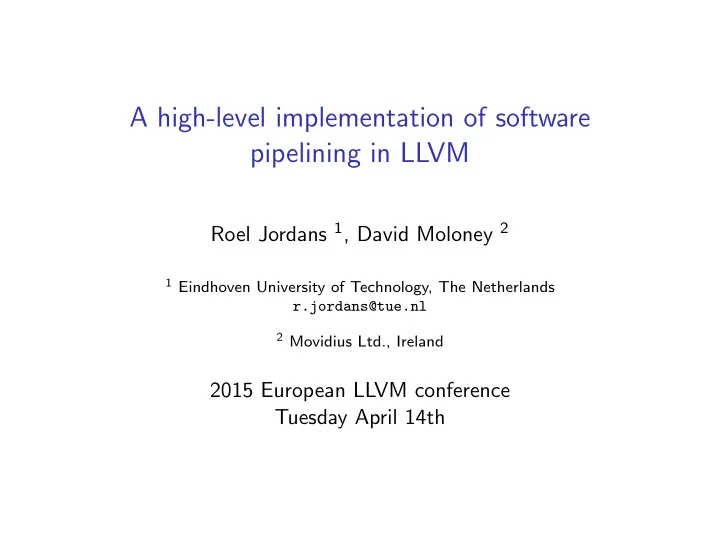

A high-level implementation of software pipelining in LLVM Roel Jordans 1 , David Moloney 2 1 Eindhoven University of Technology, The Netherlands r.jordans@tue.nl 2 Movidius Ltd., Ireland 2015 European LLVM conference Tuesday April 14th
Overview Rationale Implementation Results Conclusion
Overview Rationale Implementation Results Conclusion
Rationale Software pipelining (often Modulo Scheduling) ◮ Interleave operations from multiple loop iterations ◮ Improved loop ILP ◮ Currently missing from LLVM ◮ Loop scheduling technique ◮ Requires both loop dependency and resource availability information ◮ Usually done at a target specific level as part of scheduling ◮ But it would be very good if we could re-use this implementation for different targets
Example: resource constrained
Example: data dependencies
Source Level Modulo Scheduling (SLMS) SLMS: Source-to-source translation at statement level Towards a Source Level Compiler: Source Level Modulo Scheduling – Ben-Asher & Meisler (2007)
SLMS results
SLMS features and limitations ◮ Improves performance in many cases ◮ No resource constraints considered ◮ Works with complete statements ◮ When no valid II is found statements may be split (decomposed)
This work What would happen if we do this at LLVM’s IR level ◮ More fine grained statements (close to operations) ◮ Coarse resource constraints through target hooks ◮ Schedule loop pipelining pass late in the optimization sequence (just before final cleanup)
Overview Rationale Implementation Results Conclusion
IR data dependencies ◮ Memory dependencies ◮ Phi nodes
Revisiting our example: memory dependencies define void @foo(i8* nocapture %in , i32 %width) #0 { entry: %cmp = icmp ugt i32 %width , 1 br i1 %cmp , label %for.body , label %for.end for.body: ; preds = %entry , %for.body %i .012 = phi i32 [ %inc , %for.body ], [ 1, %entry ] %sub = add i32 %i.012 , -1 %arrayidx = getelementptr inbounds i8* %in , i32 %sub %0 = load i8* %arrayidx , align 1, !tbaa !0 %arrayidx1 = getelementptr inbounds i8* %in , i32 %i .012 %1 = load i8* %arrayidx1 , align 1, !tbaa !0 %add = add i8 %1 , %0 store i8 %add , i8* %arrayidx1 , align 1, !tbaa !0 %inc = add i32 %i.012 , 1 %exitcond = icmp eq i32 %inc , %width br i1 %exitcond , label %for.end , label %for.body for.end: ; preds = %for.body , %entry ret void }
Revisiting our example: using a phi-node define void @foo(i8* nocapture %in , i32 %width) #0 { entry: %arrayidx = getelementptr inbounds i8* %in , i32 0 %prefetch = load i8* %arrayidx , align 1, !tbaa !0 %cmp = icmp ugt i32 %width , 1 br i1 %cmp , label %for.body , label %for.end for.body: ; preds = %entry , %for.body %i .012 = phi i32 [ %inc , %for.body ], [ 1, %entry ] %0 = phi i32 [ %add , %for.body ], [ %prefetch , %entry ] %arrayidx1 = getelementptr inbounds i8* %in , i32 %i .012 %1 = load i8* %arrayidx1 , align 1, !tbaa !0 %add = add i8 %1 , %0 store i8 %add , i8* %arrayidx1 , align 1, !tbaa !0 %inc = add i32 %i.012 , 1 %exitcond = icmp eq i32 %inc , %width br i1 %exitcond , label %for.end , label %for.body for.end: ; preds = %for.body , %entry ret void }
Target hooks ◮ Communicate available resources from target specific layer ◮ Candidate resource constraints ◮ Number of scalar function units ◮ Number of vector function units ◮ . . . ◮ IR instruction cost ◮ Obtained from CostModelAnalysis ◮ Currently only a debug pass and re-implemented by each user (e.g. vectorization)
The scheduling algorithm ◮ Swing Modulo Scheduling ◮ Fast heuristic algorithm ◮ Also used by GCC (and in the past LLVM) ◮ Scheduling in five steps ◮ Find cyclic (loop carried) dependencies and their length ◮ Find resource pressure ◮ Compute minimal initiation interval (II) ◮ Order nodes according to ’criticality’ ◮ Schedule nodes in order Swing Modulo Scheduling: A Lifetime-Sensitive Approach – Llosa et al. (1996)
Code generation entry entry T F T F for.body.lr.ph T F for.body .lp.prologue for.body.lp.prologue for.body .lp.kernel T F for.body for.body.lp.kernel T F T F for.body .lp.epilogue for.body.lp.epilogue for.end for.end CFG for 'loop10' function CFG for 'loop5b' function ◮ Construct new loop structure (prologue, kernel, epilogue) ◮ Branch into new loop when sufficient iterations are available ◮ Clean-up through constant propagation, CSE, and CFG simplification
Overview Rationale Implementation Results Conclusion
Target platform ◮ Initial implementation for Movidius’ SHAVE architecture ◮ 8 issue VLIW processor ◮ With DSP and SIMD extensions ◮ More on this architecture later today! (LG02 @ 14:40) ◮ But implemented in the IR layer so mostly target independent
Results ◮ Good points: ◮ It works ◮ Up to 1.5x speedup observed in TSVC tests ◮ Even higher ILP improvements ◮ Weak spots ◮ Still many big regressions (up to 4x slowdown) ◮ Some serious problems still need to be fixed ◮ Instruction patterns are split over multiple loop iterations ◮ My bookkeeping of live variables needs improvement ◮ Currently blocking some of the more viable candidate loops
Possible improvements ◮ User control ◮ Selective application to loops (e.g. through #pragma ) ◮ Predictability ◮ Modeling of instruction patterns in IR ◮ Improved resource model ◮ Better profitability analysis ◮ Superblock instruction selection to find complex operations crossing BB bounds?
Overview Rationale Implementation Results Conclusion
Conclusion ◮ It works, somewhat. . . ◮ IR instruction patterns are difficult to keep intact ◮ Still lots of room for improvement ◮ Upgrade from LLVM 3.5 to trunk ◮ Fix bugs (bookkeeping of live values, . . . ) ◮ Re-check performance! ◮ Fix regressions ◮ Test with other targets!
Thank you
Recommend
More recommend